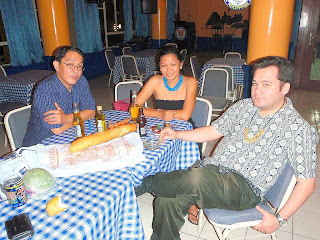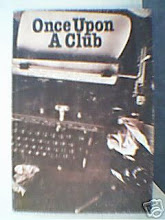By Mitos Garcia
When Marcelo H. del Pilar founded the Diayryong Tagalog in 1882, he never dreamed there would come a day that the Philippine press would become an organized force against any kind of repression.
Neither could he have imagined that, in a mere 70 years, the Philippine press would have evolved from the clandestine operations of a few stalwarts here and abroad, to a full-pledged, nationwide force with its own building beside Jones bridge, across the Plaza Cervantes – about two kilometers from the birthplace of del Pilar’s contemporary, revolutionary leader Andres C. Bonifacio in Binondo.
On October 29, 1952, the national Press Club came into being as a formal organization, duly registered with the Securities and Exchange Commission, after two years of gestation. Former NPC president Olaf Giron wrote this book “Once Upon a Club”.
Giron’s book cites an “anonymous” newsman’s tale published by the NPC in 1962 to commemorate its first 10 years of existence edited by Amado Inciong.
Is says the idea of organizing “was born during a huddle of Manila City Hall and police reporters one timorous afternoon in 1950. Scene of the huddle was Aling Miling’s store, where the reporters used to park to sip cheap coffee or dine in those unaffluent days.”
The reporters had been alarmed by threats of reprisals from some “dreaded” City hall and police characters brought about by “unflattering reports” about them in the newspapers.
“Hence, instead of engaging in ‘smart’ conversations, as usual, the reporters talked grimly this time. Everybody was immediately concerned with his personal safety and the freedom of the press. Out of this huddle shaped up the need, painfully felt by all, for an ‘institutional shelter,’ for organizing the working press into a body which can exert restraining influence upon those who would want to suppress, infringe, limit or otherwise undermine press freedom. Thus was conceived the NPC idea.”
This was the post-war press, which found itself in physical danger due to its fearless reporting. But unlike in Del Pilar’s time, the threat did not come from a foreign conqueror but from fellow Filipinos gone wrong.
Hoever, like the Filipino newsmen of Del Pilar’s time, the post-war reporters refused to be cowed. Instead, they banded together to fight the evil that begun to make its iron hand felt.
But to quote Giron’s book: “The idea of uniting the working press on a nationwide scale was not new. Before the war there was the Manila Press Club, which sought to organize all metropolitan journalists along the pattern of trade unionism.
“Dismembered during the war years, this was revived immediately after the liberation in the form of the real trade union – the Philippine Newspaper Guild, which played a leading role in the formation and direction of the now defunct Congress of Labor Organizations.”
The Philippine Newspaper Guild was dissolved together with the militant Congress of Labor Organizations, which had been outlawed allegedly for “communist involvement.”
Having seen this happen, the newly-founded NPC’s leaders decided to limit the Club’s functions to providing entertainment and relaxation to its members, at the same time keeping it away from getting embroiled in controversial issues or advocacies.
Domingo C. Abadilla, NPC president 9in 1957-1958, wrote a glowing account about the Business Writers Association of the Philippines (BWAP) which sponsored the first two luncheon meetings which formulated plans to organize the Club.
The first was held at the Panciteria Nacional, where the group approved the idea of organizing a federation. During the second meeting, however, they created an 18-man “Executive committee for the Establishment of a Newspapermen’s Organization,” which decided to make the NPC a non-stock corporation. They discarded the federation idea, Membership was to be individual.
“Politicians, writes Giron, “immediately sensed the uses of the NPC in the politics of power … The meeting (and first elections) was held at Malacanang, nerve center of the national politics, with the late President (Elpidio) Quirino as host and, to the surprise of the President himself, also guest speaker.”
The first president elected in the Malacanang polls was Luciano Millan, who served for two consecutive terms from 1952 to 1954. (He later became a member of Congress).
Millan was followed in 1954 by Eugenio Santos, for a one-year term, after which Teodoro F. Valencia was elected. Valencia was the last NPC president, because it was in his term that the new NPC building was finished.
How the NPC obtained the land and got the building constructed ism, itself, an interesting and significant milestone in the annals of the Philippine press.
Antonio Alano of the Manila Bulletin, Jose Guevara of the Manila Times, and Jose Nable of the Manila Chronicle, Congress reporters of note, worked to get Congress to enact a law authorizing the President of the NPC a parcel of government land on Magallanes Drive, for a nominal price of one peso.
Congress passed R.A. 905 authorizing the sale of 5,184.7 square meters of land to the NPC, and President Quirino signed it into law on December 23, 1953. Millan paid the price and the deed was made over to the NPC.
Where the NPC building stands is actually a 4,288-squaremeter lot (under Transfer Certificate of Title no. 38690 entered at Manila on March 8, 1955, after Valencia became NPC president) of prime real estate in historic Intramuros. The PLDT now occupies about one-half of the land on a 50-year lease.
The building itself is a historic monument to the ideal of press freedom and unity among colleagues in the newspaper industry, designed by Architect Angel E. Nakpil, and constructed by Alberto T. Abaya.
In the 1953 national elections, President Quirino lost to Ramon Magsaysay who happened to be as generous to the NPC. He appointed NPC president Eugenio Santos as general manger of the Philippine Charity Sweepstakes Office, which enabled him to get the Rehabilitation Finance Corporation to approve a loan for the construction of the NPC building.
The loan, amounting to P354,600, was released in 1954 on representation made by Valencia, who had by then succeeded Santos as NPC president.
The NPC building was inaugurated amid much fanfare and anticipation on December 30, 1955. President Magsaysay was the sponsor, along with several cabinet members, other government officials and other donors.
Valencia’s heroic efforts to give the Philippine press a truly viable home-away-from-home must be emphasized here. He worked almost single-handedly to raise funds for the installation of an elevator and air conditioners.
His first contributor President Magsaysay, and this set the wheels in motion that got him P150,000. Businessmen and other individuals followed the President’s example. The bigges contributors, according to Giron, were The Manila Times and the Manila Chronicle, which gave P5,000 each.
However, some credit must also go to the burgeoning female population of the Club. According to Giron: “The women of the press were the first big contributors of the NPC building fund. They put up a benefit show at the Manila Hotel and turned over the collection to the NPC.”
“To this amount were added the proceeds from the first Gridiron dinner held at the University of the East auditorium by the entertainment committee headed by Joaquin P. Roces of the Manila Times.”
When the levators and air conditioners had been installed, what funds he still had left over Valencia used to furnish the NPC bar (the NPC’s main attraction donated by Stanvac), library (books donated by the Asia foundation) and the restaurant (with music system donated by Don Andres Soriano).
The origins of the famous mural painted on the south wall of the NPC restaurant by famous artist Vicente Manasala remain obscure, however.
Giron’s book mentions in passing that Valencia purchased the Manasala mural, without giving further details. But according to Neal Cruz (As I See It, NPC Digest, July 2001 issue), the mural is a “donation of the Lopez family ... A condition of the donation, as I heard it, is that the mural would be returned to the Lopez family once it is removed from the NPC premises.”
While the building was under construction, the plan included “a huge mural in the dining room and the planners solicited the financial help of the Lopez patriarch, Don Eugenio Lopez, Sr. , then owner of the Chronicle.”
With his own money, Valencia purchased a television set for the NPC and the records of the music system.
In its 50 years of existence, the NPC has gone through much trial and travail. Unlike other big organizations, it cannot charge high membership fees due to the pecuniary deficiency of most media members.
Underpaid, overworked, they all look forward to a couple of hours of socializing over a bottle or two of beer, meticulously priced at a minimum at the NPC bar. More affluent members take red or white wine and some “pulutan.”
The Club’s Board of directors decided to close down temporarily the bar and restaurant, due to a labor problem that literally brought in down to its knees. To compensate, a garden restaurant was opened on the front grounds of the Club so that members can still have their enjoyment.
In fairness to the present administration the Club’s financial woes are a problem that has festered for decades. As early as Mac Vicencio’s incumbency (1962-1963) the Club was found to be almost bankrupt. Somebody called Vicencio “the first NPC reform president.”
In 1976, the Joaquin Cuanan & Co. was authorized by Board Resolution 17-76 (9-8) to audit the NPC, due to certain defects noted by then NPC president Pat Gonzales in the accounting and financial aspects of Club operations. The auditing firm’s report revealed some shocking things, better not mentioned her.
Under the present circumstances, as the inheritor of the biggest set of problems the Club has ever faced – not just financial but also having to do with labor and other arenas – then perhaps Louie Lograta can aptly be called the second NPC reform president. -- lifted from: THE NATIONAL PRESS CLUB OF THE PHILIPPINES 50 GOLDEN YEARS ###

 The Monday Club was formed to further the friendships of colleagues-in-arms. This was conceptualized by
The Monday Club was formed to further the friendships of colleagues-in-arms. This was conceptualized by 

 CES DRILON KIDNAPPING. Undersecretary Lorelie Fajardo, Deputy Presidential Spokesperson (third from left) clarifies the government’s stand regarding issues surrounding the kidnapping of broadcast journalists Ces Drilon, her news team and a Mindanao based professor to a crowd of journalists and fellow guest Col. Ernesto Torres, (left) spokesman of the Armed Forces of the Philippines and officers at a NO HOLDS BARRED news forum at the Headline Restaurant of the National Press Club (NPC) in Intramuros, Manila.
CES DRILON KIDNAPPING. Undersecretary Lorelie Fajardo, Deputy Presidential Spokesperson (third from left) clarifies the government’s stand regarding issues surrounding the kidnapping of broadcast journalists Ces Drilon, her news team and a Mindanao based professor to a crowd of journalists and fellow guest Col. Ernesto Torres, (left) spokesman of the Armed Forces of the Philippines and officers at a NO HOLDS BARRED news forum at the Headline Restaurant of the National Press Club (NPC) in Intramuros, Manila.












